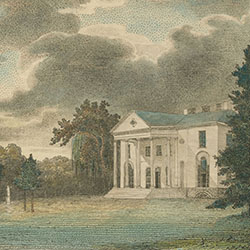 |
William Birch, Woodlands, The Seat of Mr. Wm. Hamilton Pennsylva. (Philadelphia, 1809). Hand-colored engraving. Library Company of Philadelphia. Gift of S. Marguerite Brenner. |
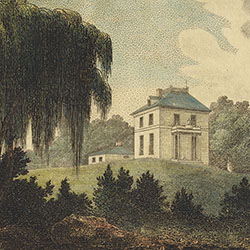 |
William Birch, Solitude in Pennsylva. Belonging to Mr. Penn (Philadelphia, 1809). Hand-colored engraving. Library Company of Philadelphia. Gift of S. Marguerite Brenner. |
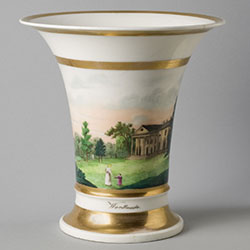
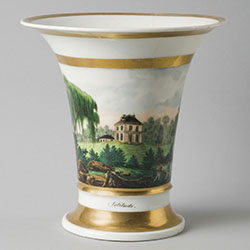
|
Pair of vases ornamented with views from Birch’s Country Seats. (Philadelphia: Tucker Factory, ca. 1827). Glazed porcelain with enamel and gilt decoration. Philadelphia Museum of Art: Gift of Miss Mary Lea Perot, 1958. |
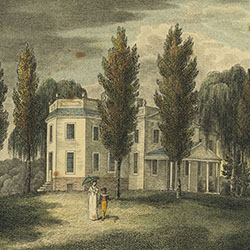 |
William Birch, Hoboken in New Jersey, the Seat of Mr. John Stevens (Philadelphia, 1809). Hand-colored engraving. Library Company of Philadelphia. Gift of S. Marguerite Brenner. |
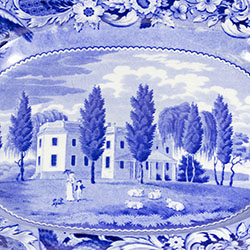 |
Platter ornamented with view from Birch’s Country Seats. (Burslem, England: Firm of Joseph Stubbs, ca. 1825). Glazed earthenware with transfer-printed decoration. Private Collection.
The British firm of Joseph Stubbs used a number of Birch’s views to decorate their wares. Sheep and a frolicking dog have been added to enhance the bucolic nature of John Stevens’ New Jersey residence reproduced on this platter. |
| Although none of the original subscribers to William Birch’s The City of Philadelphia hailed from Europe, his depictions of the American city soon made the trans-Atlantic voyage. |
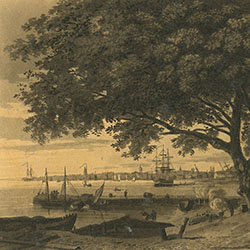 |
M. Marigot, View of the City and Port of Philadelphia, on the Delaware taken from Kensington (London: James Andee, 1807). Aquatint. The Library Company of Philadelphia.
This print, along with the six other images of Philadelphia used to illustrate Charles William Janson’s The Stranger in America (1807), were all clearly based on Birch’s work. Janson’s book includes only three non-Philadelphia scenes. The British travel writer deflects any potential criticism of this imbalance by stating in the preface that “scarcely any other city in America contains any edifice worthy of delineation.” |
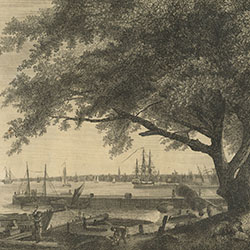 |
William Birch, The City and Port of Philadelphia, on the River Delaware from Kensington (Springland Cot. near Bristol, Pennsylvania: W. Birch, 1800). Engraving. The Library Company of Philadelphia. |
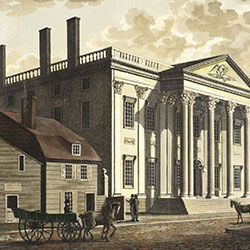 |
Carl Fredrik Akrell after Axel Klinckowström, Gerard’s Bank in Philadelphia (Stockholm, ca. 1824). Hand-colored aquatint. Library Company of Philadelphia. Gift of Martin P. Snyder in memory of June Avery Snyder.
This print originally appeared as an illustration in Atlas Til Friherre Klinckowström’s Bref Om De Förente Staterne (Stockholm: Eckstein, 1824), an account of a three-year visit to the United States by a Swedish aristocrat. The illustration was updated to reflect Stephen Girard’s purchase of the First Bank of the United States after the expiration of its charter in 1811. Klinckowström’s book also included an illustration of Hoboken clearly based on the view from Birch’s Country Seats. |
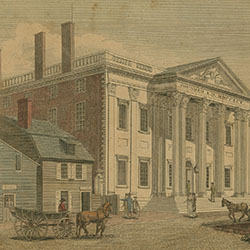 |
W. Birch & Son, Bank of the United States, in Third Street, Philadelphia. (Philadelphia: W. Birch & Son, 1799). Hand-colored engraving. Library Company of Philadelphia. |
| Anniversaries by their nature evoke interest in the past. Founder’s Week, the celebration of the 225th anniversary of William Penn’s founding of Philadelphia, served as a touchstone for packaging and selling views of “old Philadelphia,” including those created by William Birch. From postcard sets to commemorative booklets, Birch’sviews of the city were marketed with a nostalgic eye to the past. |
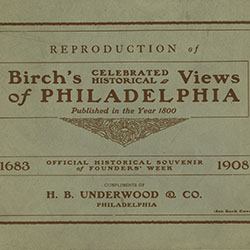 |
Reproduction of Birch’s Celebrated Historical Views of Philadelphia ... Compliments of Underwood & Co. (Philadelphia: R. M. Palmer, 1908). Library Company of Philadelphia. Gift of Louise Beardwood.
Numerous Philadelphia firms advertised their businesses by distributing a commemorative booklet containing all of Birch’s city views. The booklet’s introduction reads in part: “The costumes of the period, the general views of the buildings, street scenes, historical landmarks, then the show features of the city, etc., compared with the present, make the phenomenal strides in advancement now achieved seem almost incredible.” Captions below some of the images updated the viewer to the more recent history of the site depicted. |
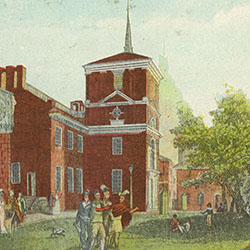
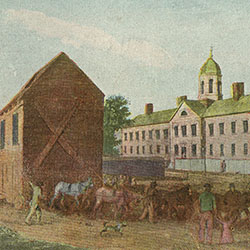
|
Views of Old Philadelphia (In Color) (Philadelphia: Adelbert Kohn, 1908). Letterpress halftone. Library Company of Philadelphia. Joe Freedman Collection of Philadelphia Ephemera.
This booklet reproduced some of Birch’s views along with city scenes by other artists, including Edward Mumford (1812-1858) and William Breton (ca. 1773-1855). Only the work of William Birch, however, is credited, including a view that he did not create. |
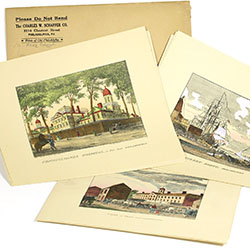 |
Prints of Old Philadelphia (Philadelphia, ca. 1915). Color engravings. Library Company of Philadelphia. Joe Freedman Collection of Philadelphia Ephemera.
The Charles W. Schaffer Co., a Philadelphia plumbing supplier and later an auto painting business, used Birch’s images to market its business. The company distributed these reproductions of the views presumably to customers in good standing or to perspective customers. Little attempt was made to follow the color palette employed on the original Birch engravings. This set may have originally been produced for the 225th anniversary of the city’s founding in 1908, but the Charles W. Schaffer Co. was not located at the address printed on the accompanying envelope until 1915. |
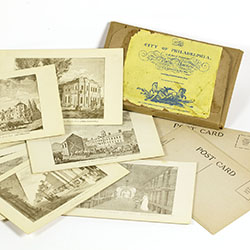 |
Birch’s Views of Philadelphia (Philadelphia, 1908). Photomechanical prints. Library Company of Philadelphia. Joe Freedman Collection of Philadelphia Ephemera.
This set of postcards issued for Founders’ Week included at least two views not part of the original twenty-seven scenes in Birch’s first edition published in 1800 — The New Theatre in Chestnut Street and Schuylkill Bridge, High Street. |
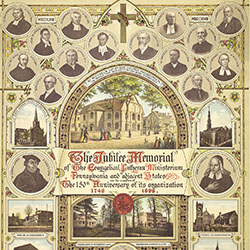 |
The Jubilee Memorial of the Evangelical Lutheran Ministerium Pennsylvania and Adjacent States (New York: Ernst Kaufmann, 1898). Chromolithograph. Library Company of Philadelphia. The Roughwood German-American Collection. Gift of Dr. Don Yoder and William Woys Weaver.
Although none of the artists whose work is reproduced on this broadside commemorating the 150th anniversary of the first Lutheran church body in North America received any acknowledgment, Birch’s depiction of the Lutheran Church from The City of Philadelphia forms the central vignette. |
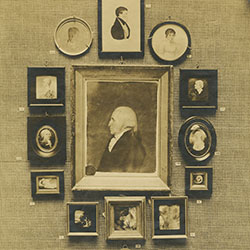 |
Display from the Tenth Annual Exhibition of Miniatures, Pennsylvania Academy of the Fine Arts, 1911. Gelatin silver photograph. The Library Company of Philadelphia.
William Birch’s enamels were exhibited regularly at the Pennsylvania Academy of the Fine Arts (PAFA) beginning in 1811 at the institution’s First Annual Exhibition of the Society of Artists of the United States and continuing until a few years before Birch’s death in 1834. The institution also recognized Birch’s talent as a miniaturist posthumously. Eighteen of his works, both on paper and enamel, were displayed at a 1911 PAFA exhibition along with the works by Thomas Sully (1783-1872) and James (1749-1831) and Charles Willson Peale (1741-1827), among others. In this photograph, only the central portrait of George Washington (1732-1799) and the oval portrait in the upper left are not Birch’s work. Several of Birch’s pieces seen here can be found in the Library Company’s William Birch, Ingenious Artist exhibition. |
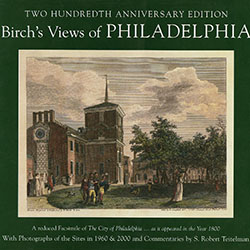 |
S. Robert Teitelman, Dust jacket of Birch’s Views of Philadelphia … with Photographs of the Sites in 1960 & 2000. (Philadelphia: The Free Library of Philadelphia, 2000). The Library Company of Philadelphia.
Throughout the 20th century, Birch’s views have inspired projects examining the city’s changing urban landscape. To commemorate the 300th anniversary of Philadelphia’s founding in 1982, collector S. Robert Teitleman published a book comparing his 1960 and 1982 photographs with Birch’s 1800 views of the same scenes. In honor of the 200th anniversary of Birch’s work, Teitleman produced an update to his project in 2000. |


















